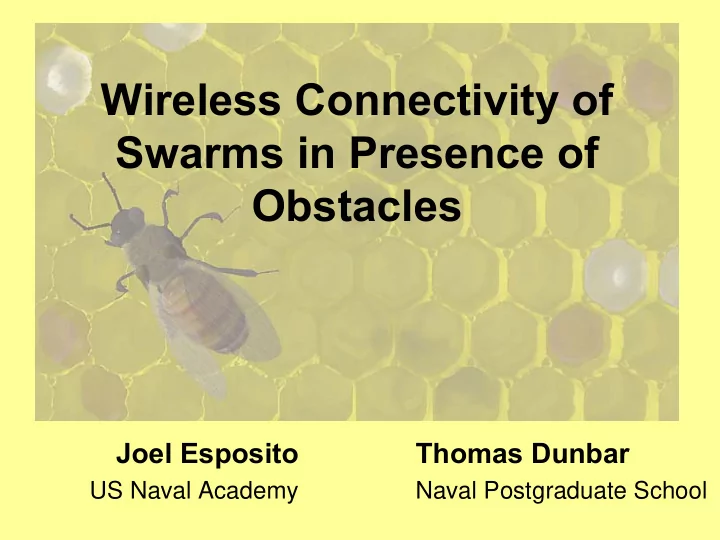

Wireless Connectivity of Swarms in Presence of Obstacles Joel Esposito Thomas Dunbar US Naval Academy Naval Postgraduate School
Motivation Goa l EDGE = Range + Line of Sight
Problem Statement Given: • N mobile holonomic robots • Workspace, W init q 2 • Initial positions, 1 4 final • Final Positions, q 3 4 3 2 1
Problem Statement Given: • N mobile holonomic robots • Workspace, W init q 2 • Initial positions, 1 4 final • Final Positions, q ⊆ * • Critical communication graph, C G 3 (EDGE = Range + Line-of-sight) 4 3 2 1
Problem Statement Given: • N mobile holonomic robots • Workspace, W init q 2 • Initial positions, 1 4 final • Final Positions, q ⊆ * Critical communication graph, C G • 3 (EDGE = Range + Line-of-sight) Problem: = Design a distributed control law � q u i i which achieves final position while preserving all critical edges of G (i.e range and LOS) 4 3 2 1
Problem Statement Given: • N mobile holonomic robots • Workspace, W init q • Initial positions, 1 final • Final Positions, q 2 ⊆ * Critical communication graph, C G • (EDGE = Range + Line-of-sight) 4 3 Problem: = Design a distributed control law � q u i i which achieves final position while preserving all critical edges of G (i.e range and LOS) 4 3 2 1
Problem Statement Given: • N mobile holonomic robots • Workspace, W init q • Initial positions, final • Final Positions, q 1 ⊆ * Critical communication graph, C G • (EDGE = Range + Line-of-sight) 2 4 Problem: Design a distributed control law 3 = which achieves final position while � q u preserving all critical edges of G i i (i.e range and LOS) 4 3 2 1
Problem Statement Given: • N mobile holonomic robots • Workspace, W init q • Initial positions, final • Final Positions, q ⊆ * Critical communication graph, C G • (EDGE = Range + Line-of-sight) Problem: = Design a distributed control law � q u i i which achieves final position while 2 3 1 preserving all critical edges of G 4 (i.e range and LOS) 4 3 2 1
Obvious Infeasibility 2 2 1 1 4 3 3 4 4 3 2 1 4 3 2 1 Cycles in different homoptic Start and goal in different connected equivalence classes components of W
Related work Formations: • Fixed relative pose • Leader Desai, Kumar, Fierro Closely Related Works: • Maintaining network connectivity • Multi-hops networks • Obstacle free? Flocks: Spanos, Murray; Zavlanos Pappas • Constr. rel. pose Bullo, Cortes, Notarstefano • Distributed • Swarm-wide objective Reynolds, Reif, Bishop, Tanner, Pappas, Moorse, Jadbabaie Passiano,Olfati-Saber, Murray
Approach: Potential Functions 1. Range: 2. Line of Sight: (cm 2 /sec) φ distance to other robot (cm) 3. Go To Goal: φ (cm 2 /sec) Navigation function [Rimon & Kodischek] Y (cm) ) m c ( X
Addition of Potentials is Dangerous! Line of Go-to Range Sight goal Parallel Comp Algorithm go to line of ∇ φ goal IF exists such that sight i ∇ φ × ∇ φ > ∨ ∇ φ × ∇ φ < ∀ ≠ � ( ) 0 ( ) 0, j i i j i j ∂ φ ∂ φ ⎡ ⎤ ⎡ ⎤ v v Then select so that − ⋅ x ≤ j j ⎢ ⎥ ⎢ , ⎥ 0 ∂ ∂ range v ⎣ x y ⎦ ⎣ ⎦ � ELSE y v Infeasible! ∇ φ Discard some i Low Level Control: Final Velocity
Parallel Composition controller: concept 1 Goal Potential 2 [Esposito Kumar 2002]
Constraint Range Parallel Composition controller: concept 1 2
Parallel Composition controller: concept Line Of Sight Constraint 2 Range 1 Constraint
Parallel Composition controller: concept Line Of Sight Constraint 2 Range 1 Constraint 2 O P ( ) Efficient: Computing directions is (all pairs of cross products) Complete: Generates solution if feasible. If infeasible, algorithm is conclusive. Stability: Common Lyapunov function.
Validation
Completeness: Is the composition always feasible? 1 2 2 1 2 1
A Necessary Condition Infeasible Loop homotopic to constant loop! 2 2 1 1 1 1 2 2 • A connected swarm cannot Neighbors must select paths “split” an obstacle in same (straight line) • No distributed, global homotopy class! solution !!!
Conjecture: Feasible, iff initial conditions are not “split” by saddle stable manifolds Stable Manifold manifold infeasibility 1. Any feasible path is a loop homotopic to trivial loop 2. must cross stable manifold an even number of times, 3. requires increasing potential function
Conjecture: Feasible, iff initial conditions are not “split” by saddle stable manifolds manifold infeasibility 1 2 1. Potential peaks in dimension along edge (range violated) 2. Sign of derivative transverse 2 to edge changes >=2 times (LOS violated) 1 3. Turns out there is no local condition for a stable manifold? Future work….
Swarm Wireless Connectivity w/ Obstacles Thomas Dunbar Joel Esposito Naval Postgraduate School US Naval Academy 00 frame 4 50 goal frame 3 00 50 00 frame 2 frame 1 50 0 0 50 100 150 200 250 300
Recommend
More recommend